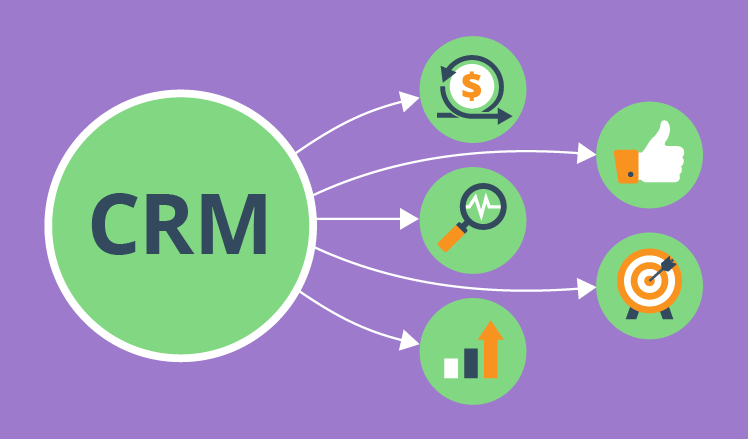5 use cases of CRM software beyond sales automation
Initially, CRM software appeared as a sales management tool that would capture customer data from multiple channels and help to coordinate interactions with customers throughout the sales cycle. Step-by-step, it evolved from a customer bookkeeping system into sales people’s daily assistant in building durable relationships with customers.
A sales-oriented CRM will store crucial details about customers and activities, visualizes leads’ movement through the sales pipeline, allows easy updates and shares of the data so as to enable collaboration of all the involved members (sales people, customer service assistants, account managers, etc.). Through automation of routine tasks, it lets companies increase sales process efficiency (e.g., to win and retain more customers with the same workforce). Still, while the sales-supporting capacity of CRM software (assistance in sales process standardization, lead nurturing and customer retention) is recognized by 90% of companies (stats by SuperOffice), our CRM consulting practice shows that the following 5 strategic capabilities of CRM tools are often overlooked. Let’s look at them in more detail.

1. CRM for better sales management
CRM tools allow to automate sales workflows so as to add consistency and speed up sales activities (such as systematical lead nurturing). Rewarding as it is, this is not sales managers’ ultimate dream. Additionally, a CRM system can be used by sales managers to set sales goals and track their fulfillment, as well as to visualize progress for assignees to keep them motivated.
Team performance analysis, both in its entirety and broken down by individuals, can make regular performance reviews fact-based and more actionable. For example, CRM data can help sales managers to:
- Indicate top and weak performers
- Spot specific sales performance problems and their reasons (e.g., Jane wins fewer customers as she spends twice as much time as other team members to close a deal)
- Identify poor and strong strategies across the sales cycle (e.g., during customer acquisition or retention)
At the next stage, CRM can act as a sales reinforcement tool. For example, efficient sales behaviors recognized after analyzing top performers’ activities can be delivered as in-CRM tips to weaker team members. Also, special algorithms can be applied to suggest cross-selling and upselling opportunities to a sales person based on their customer’s purchase history and previous similar cases that were a success.
2. CRM for protection against competitors
Customer loyalty is tested every time a competitor launches an aggressive marketing campaign. While new market players can access the same resources and use the same channels, strong customer relationships are the best shield against attacks on a company’s market share. According to Rockefeller, 82% of customers switch brands because they don’t feel care. Consequently, personalized communication with customers today can be a source of a future competitive advantage.
With a CRM system, such personalization takes reasonable efforts. CRM consultants suggest starting the journey with prioritizing 360-degree customer profiles. Those should accumulate data from sales force and customer service reps at all touchpoints, as well as analytical insights based on customers’ purchase and browsing history and social network activities (for B2C).
Knowing the customer well allows a company not only to exclude irrelevant communication (duplicate emails, irritating surveys) but also to provide exceptional service at every stage of the customer journey. For example, a service assistant instantly learns the details of the customer’s purchase via CRM, or a sales person shows care with a customer call after an issue is fixed by the support center.
A company won’t have to create an illusion of a personal touch if it enables the staff to be caring. With tips linked to a CRM user role, service assistants and sales people will get help from that particular share of 360-degree customer profiles that are relevant to their tasks.
3. CRM for strategic marketing
Ample CRM data makes it helpful at the pre-sales and post-sales stages as well. Customer sentiment gathered by sales people and via surveys can hint the marketing department at the market opportunities (like, the idea of a new or complementary product/service, improvements to the current offering). Automated to some extent, CRM data analysis will help to timely identify market trends and levels of interest in the company’s products. Subsequently, marketers can use these insights to adjust the marketing strategy.
Also, in-CRM analysis of customer data can be used to narrow down customer segments and target them with more precise (and effective) messages. And finally, with certain analytical factors introduced to the system by CRM consultants, marketers will be aware of the results of their marketing efforts in terms of revenue and pipeline activity. Fact-based analysis of marketing campaigns, identification of the best performing channels and even ad messages – that’s the basis for future marketing improvements.
Read also:
4. CRM for proactive strategic management
Whether it’s about entering a geographic market, launching a product, or surviving competition, CRM enables the executives to detect problems early, before a company loses money and customers. Changes in lead generation and their pipeline movement, a slowdown in loyal customers’ response – these are signs to launch a dynamic in-CRM analysis to find out the reasons for dwindling results (maybe, those are trends in the market or industry, or a competitor’s predatory pricing'). With custom dashboards tailored to executive roles, CEO, CFO, CMO, VP of Marketing, or VP of Sales will be able to monitor key indicators they need so as to make more informed decisions.
5. CRM for increasing profitability
In-CRM customer data analysis lets a company know more about their most lucrative customers so as to maintain relationships with them. Monitoring of the high-LTV customers’ purchase history and responses to sales and marketing activities will help to timely react to negative signs and as a result better retain such key customers.
Company executives (CEO and CFO), in their turn, can use CRM data to forecast revenue and manage profitability. Broader goals for increasing revenue and decreasing costs can be split into smaller ones and monitored in the CRM system. For example, to increase cash inflow, a company can set cross-selling and upselling targets. At the sales agents’ level, best practices visible for weaker performers in a CRM will let them convert more leads, while automated nurturing notifications will save all sales agents’ time, allow processing of more leads per quarter, and as a result raise returns on the employment costs.
Advanced CRM as the next step
This article by no means disregards the benefits of a sales-oriented CRM tool. Its initial mission will remain, no matter how many years will pass. Still, today CRM consultants advise to look at the CRM software from a wider perspective and use its data for a company’s strategic development. We think this is the next maturity level of CRM adoption, do you? Feel free to share your thoughts in the comment feed.

